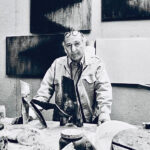Al Held
Al Held (1928-2005) was an American painter renowned for his large-scale abstract geometric paintings. Known for his meticulous attention to detail and his bold, architectural compositions, Held played a significant role in the evolution of abstract art in the 20th century. His work is celebrated for its exploration of space, depth, and the interplay of forms and colors.

Early Life and Education
Al Held was born on October 12, 1928, in Brooklyn, New York, to a working-class family. He grew up in the East Bronx, an environment that, despite its lack of exposure to high culture, provided him with a rich tapestry of urban experiences. His early years were marked by a sense of adventure and a desire to break away from the constraints of his surroundings.
Held’s formal education was interrupted by his service in the United States Navy from 1945 to 1947. After his military service, he utilized the G.I. Bill to attend the Art Students League of New York. This institution, known for its open structure and emphasis on individual exploration, provided Held with his first significant exposure to the world of art.
In 1951, Held received a scholarship to study in Paris at the Académie de la Grande Chaumière. This period was transformative for Held, as he immersed himself in the vibrant Parisian art scene and became influenced by the works of European modernists such as Piet Mondrian and Kazimir Malevich. The exposure to European abstraction would leave a lasting impact on his artistic development.
Early Career and Artistic Evolution
Upon returning to New York in 1953, Held began to establish himself within the burgeoning Abstract Expressionist movement. His early works were characterized by gestural abstraction, reflecting the dominant style of the period. However, Held soon found himself dissatisfied with the emotional intensity and spontaneity of Abstract Expressionism. He yearned for a more structured and disciplined approach to painting.
By the late 1950s, Held had begun to move away from Abstract Expressionism and towards a more geometric and systematic form of abstraction. This shift marked the beginning of what would become his signature style: large-scale, hard-edged paintings that explored the dynamics of form and space.
Geometric Abstraction and Breakthrough Works
Held’s transition to geometric abstraction culminated in a series of black-and-white paintings that he produced in the early 1960s. These works, characterized by their stark contrasts and precise compositions, were a radical departure from his earlier gestural paintings. They established Held as a leading figure in the field of geometric abstraction.
One of Held’s breakthrough works from this period is “The Big N” (1964), a monumental painting that exemplifies his exploration of form, space, and scale. “The Big N” features a series of interlocking geometric shapes that create a sense of depth and dimensionality. The painting’s bold use of black and white enhances the visual impact of the composition, making it a powerful example of Held’s mature style.
Important Artwork: “Voyage” (1976)
One of Al Held’s most significant and celebrated works is “Voyage” (1976). This painting is an excellent representation of his mature geometric abstraction and his ability to create complex, immersive spaces on canvas.
“Voyage” (1976)
“Voyage” is a large-scale painting that measures approximately 8 feet by 12 feet. The composition is dominated by a series of overlapping geometric forms, including rectangles, squares, and trapezoids. These shapes are arranged in a way that creates a sense of depth and movement, inviting viewers to visually navigate through the space.
Held’s use of color in “Voyage” is both sophisticated and striking. The painting features a limited but vibrant color palette, with shades of blue, red, yellow, and green. These colors are meticulously applied to the geometric forms, creating a sense of harmony and balance within the composition.
One of the most notable aspects of “Voyage” is its exploration of spatial relationships. Held employs techniques such as linear perspective and foreshortening to create the illusion of three-dimensionality on a two-dimensional surface. The geometric forms appear to recede and project into space, challenging viewers’ perceptions and creating a dynamic visual experience.
The title “Voyage” suggests a journey or exploration, which is reflected in the painting’s complex composition and sense of movement. The viewer is invited to embark on a visual journey through the abstract space, experiencing the interplay of forms and colors. “Voyage” exemplifies Held’s mastery of geometric abstraction and his ability to create works that are both intellectually engaging and visually captivating.
Teaching and Influence
In addition to his work as a painter, Al Held was also a dedicated teacher and mentor. He taught at several institutions, including Yale University, where he served as a professor of art from 1962 to 1980. Held’s teaching was characterized by his emphasis on the importance of rigor, discipline, and critical thinking in the practice of art.
Held’s influence as a teacher extended beyond the classroom, as he mentored and inspired many young artists who would go on to have successful careers of their own. His commitment to exploring the possibilities of abstract art and his willingness to challenge conventions left a lasting impact on his students and the broader art community.
Later Career and Evolution
Throughout the 1980s and 1990s, Held continued to push the boundaries of geometric abstraction. His later works often featured even more complex compositions and a greater emphasis on the interplay of light and shadow. He also began to incorporate new materials and techniques, such as working with acrylic paints and experimenting with computer-generated imagery.
In the 1990s, Held produced a series of paintings known as the “Cosmos” series, which further explored themes of space and dimensionality. These works are characterized by their intricate compositions and the use of vibrant, saturated colors. The “Cosmos” series represents the culmination of Held’s lifelong exploration of geometric abstraction and his ongoing quest to create immersive, dynamic spaces on canvas.
Legacy and Impact
Al Held passed away on July 27, 2005, leaving behind a rich and influential body of work that continues to inspire and challenge artists and viewers alike. His contributions to the field of abstract art are celebrated for their innovation, precision, and depth.
Held’s work is included in the collections of major museums and galleries around the world, including the Museum of Modern Art in New York, the Whitney Museum of American Art, and the Tate Modern in London. His paintings have been the subject of numerous solo exhibitions and retrospectives, highlighting his enduring influence and significance in the history of modern art.
Personal Life and Philosophy
Al Held was known for his intellectual rigor and his deep commitment to the practice of art. He believed in the importance of discipline, structure, and critical thinking in the creative process. His approach to painting was methodical and deliberate, reflecting his belief in the power of abstract art to convey complex ideas and emotions.
Held’s personal life was marked by a sense of curiosity and exploration. He traveled extensively, drawing inspiration from the architecture, landscapes, and cultures he encountered. These experiences informed his work and contributed to his understanding of space, form, and perception.
Conclusion
Al Held’s artistic journey is a testament to his dedication to the exploration of abstract geometric art. Through his innovative compositions, meticulous attention to detail, and intellectual rigor, Held pushed the boundaries of abstract art and created works that are both visually striking and intellectually engaging. His notable work, “Voyage,” exemplifies his mastery of geometric abstraction and his ability to create dynamic, immersive spaces on canvas.
In celebrating Al Held’s life and work, we recognize his significant contributions to the evolution of abstract art and his enduring legacy as a pioneer of geometric abstraction. His paintings continue to inspire and captivate, reminding us of the power of art to challenge perceptions, evoke emotions, and transform our understanding of space and form.



